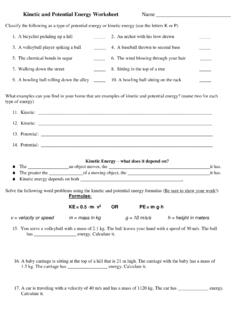Search results with tag "Kinetic and potential energy"
STEMonstrations - Kinetic and Potential Energy - NASA
www.nasa.govPotential energy (PE) is a stored form of energy that can produce motion, i.e. the “potential for motion.” Think of PE as stored energy that can become kinetic energy. You can calculate potential energy using an object’s mass and its height. PE is measured in Joules (J). PE = mgh where m = mass (kg), g = acceleration due to gravity
Kinetic and Potential Energy Lab - Tamaqua Area School ...
www.tamaqua.k12.pa.usbecause potential energy will convert to kinetic energy. or a student may say:"IF a ball is dropped from a given height, THEN it will bounce lower than the original height BECAUSE when potential energy converts to kinetic energy, some energy will be lost due to friction." Procedures: 8.Partner 1 holds or secures a meter stick vertically.
Kinetic and Potential Energy/Conservation of Energy
www.bu.eduincreased kinetic energy keeps the planet from being pulled into the sun by the greater gravitational force it experiences at this point in its path. When the planet is far from the sun, its potential energy is high and its kinetic energy low, reduced speed keeping pace with gravitational force. Drop a ball:
Kinetic and Potential Energy Worksheet Name
www.wlwv.k12.or.usSolve the following word problems using the kinetic and potential energy formulas (Be sure to show your work!) Formulas: KE = 0.5 ·m· v2 OR PE = m·g·h v = velocity or speed m = mass in kg g = 10 m/s/s h = height in meters 15. You serve a volleyball with a mass of 2.1 kg. The ball leaves your hand with a speed of 30 m/s.



